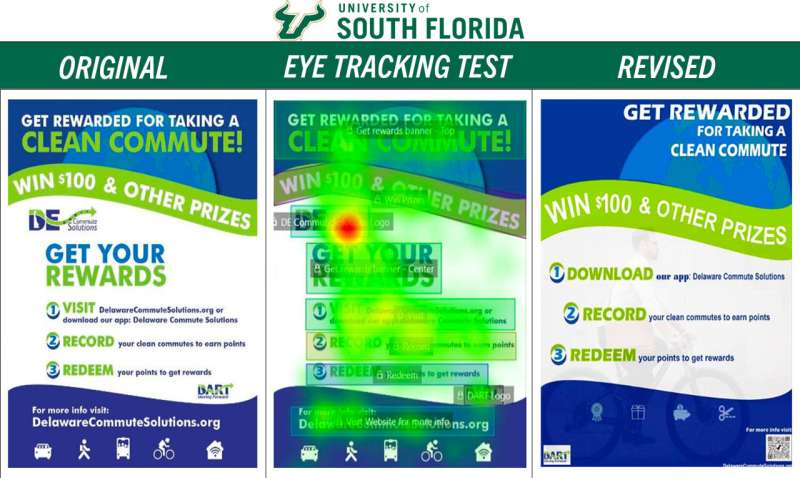This article has been reviewed according to Science X's editorial process and policies. Editors have highlighted the following attributes while ensuring the content's credibility:
fact-checked
trusted source
proofread
Eye-tracking marketing research boosts public transportation agency's ridership

One of Florida's largest passenger rail services is experiencing an increase in ridership—and leaders of a Florida Department of Transportation program that promotes alternatives to commuters who drive alone attribute some of this success to guidance from an interdisciplinary team of researchers at USF who combined eye-tracking technology and social marketing to improve the impact of marketing campaigns.
As part of a collaboration with the Florida Department of Transportation, researchers from the USF Center for Urban Transportation Research (CUTR), a College of Public Health Social Marketing expert and the Muma College of Business Center for Marketing and Sales Innovation tested a variety of materials from Commuter Assistance Programs across the country to develop data-driven marketing guidelines to improve the effectiveness of commuter marketing efforts.
"It leveraged our skills," said Robert Hammond, director of the Center for Marketing and Sales Innovation in the Muma College of Business. "This project provided us with an exciting opportunity to collaborate, be a resource for our community partners and leverage our Customer Experience Lab's unique assets to provide novel insights."
The team monitored the eye movements of 60 participants as they studied various ads and videos, such as the Tampa Bay Area Regional Transit Authority's promotional video of a new commuter app and a Delaware Commute Solutions flyer. Eye-tracking software generated heat maps and metrics of areas of interest, revealing clear patterns of focus.
Among many findings, the data showed participants tended to focus on faces, the left side of the ad and messages surrounded by white space. Areas of the ad least noticed were on the bottom and especially on the bottom right. The study participants also answered a series of questions to provide a measure of the materials' perceived effectiveness in persuading drivers to alter their commuting behavior.
Based on the findings, the team generated guidelines to revise the marketing materials and improve their effectiveness. When they retested the materials, they found a 24% improvement in comprehension, attractiveness, acceptability, relevancy and persuasiveness.
The results were even more impressive for the South Florida Regional Transportation Authority's campaign to encourage Tri-Rail ridership by offering free Uber ride vouchers to and from its rail stations, located between Miami, Fort Lauderdale and West Palm Beach, to resolve first and last mile connection issues. The initial flyer resulted in only a third of people who downloaded a voucher using it. After learning about USF's new guidelines and making adjustments, a majority of vouchers were redeemed.
"We applied the lessons learned from the CUTR effort and we redesigned our flyer. What we found was by making these changes, it was a huge success and a lot of that we attribute to the creatives for this flyer because we basically use this design for everything," Jeremy Mullings, project director for the South Florida Commuter Services, announced during a recent webinar hosted by Best Workplaces for Commuters.
"The guidelines that we have developed, and the lessons learned are informative towards new projects coming down the pipeline," said lead investigator Mahmooda Khaliq Pasha, associate professor of social marketing in the College of Public Health. "This work will be instrumental in allowing us to develop communication materials and strategies that are personalized, targeted and relevant for our target populations."
The USF team hopes these results will help additional transportation programs make further improvements and believes the findings could be widely applicable to marketing materials in a variety of industries.
"Professionals don't necessarily need to do the neuromarketing test to find out what could be improved with their materials," said Phil Winters, director of Transportation Demand Management program at CUTR. "The value lies in the best practices we found—those can be used to improve marketing materials without testing."
Provided by University of South Florida





















